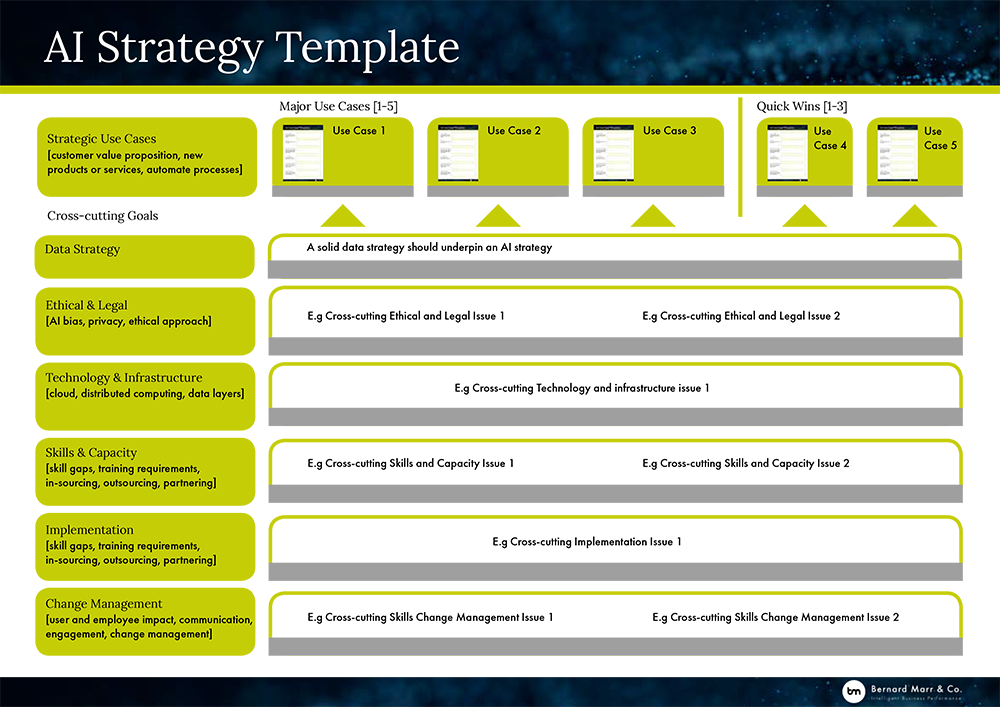How To Develop Your Artificial Intelligence (AI) Strategy – With Handy Template
2 July 2021
In a previous article I explored AI use cases – or, how your business can use AI to deliver strategic objectives. Once you’ve worked out how you want to use AI, you need to turn that into a more formal AI strategy.

In this article, I’ll help you explore your AI use cases and identify their cross-cutting themes, issues, goals and requirements, using a handy AI Strategy Template. You might like to have the accompanying AI Strategy Template open while you read this article, as I’ll refer to it throughout. The template (see above) is free to download and use.
Start with your AI strategic use cases
If you haven’t done so already, start by completing the AI Use Case Template for each of your AI priorities/projects. AI use cases will be different for each company, and will be driven by your strategic objectives. However, some common ways to use AI include:
- Developing more intelligent products
- Developing more intelligent services
- Making business processes smarter
- Automating repetitive business tasks
- Automating manufacturing processes
By fleshing out your AI use cases, you can then start to rank your AI projects in order of importance – as in, which one, two or three of these projects are most critical to the business at this point in time?
Now, turning to the AI Strategy Template, you’ll see that there’s space to include your three most pressing AI priorities at the top. In my experience, it’s also worth including a couple of ‘quick win’ AI priorities – short-term AI projects that can help you demonstrate value from AI in relatively quick, easy and inexpensive ways.
Identifying the cross-cutting issues for your AI use cases
The rest of the AI Strategy Template is broken down into AI requirements, such as technology and skills. In each of these sections, your task is to pinpoint the challenges, themes, activities, issues and goals that are common across your various AI use cases.
Why do this? Well, even though each use case/AI priority is different, they’re bound to share some common issues or challenges. By identifying these shared themes early on, you can find the most efficient, effective ways to overcome them.
Working through the rest of the template in order, let’s look at each of the AI strategy sections:
Data strategy
Your AI strategy must be underpinned by a thorough, up-to-date data strategy. After all, AI just doesn’t work without data. So, if it’s been a while since you looked at your data strategy, now is a good time to revisit it. You may find that your AI priorities will impact or change certain areas of your data strategy.
Ethical and legal issues
There are lots of ethical and legal considerations around AI, and you’re likely to encounter some of the same issues for each use case. This your opportunity to identify those cross-cutting themes.
For example, whatever way you use AI, consent and data privacy will be key considerations. You’ll also want to ensure your AI is free of bias and discrimination, and that the way you’re using AI is ethical – AI should be used for the good of the business, its employees and its customers.
Technology and infrastructure
In this section, you should aim to identify common themes around technology and infrastructure. So, what technology requirements and challenges are the same across your various AI use cases?
At this stage, I find it helps to consider the four layers of data and identify what technology you’ll need for each layer:
- Collecting data
- Storing data
- Processing (analysing) data
- Communicating insights from data
Skills and capacity
There’s a huge skills gap in AI and data. It’s therefore highly likely that your business will have various skills gaps to plug, and that these skills gaps might be common across the different use cases. There may, for example, be cross-cutting training requirements. Or perhaps you’ll need to hire new staff, or partner with an external AI provider.
Implementation
This step is about identifying the common issues, requirements or challenges around bringing your AI projects to life. What common roadblocks might stand in your way? What actions can you take to ensure you deliver on your AI objectives?
Change management
Finally, it’s vital you think about the cross-cutting issues around employee impact, engagement and communication. Your AI projects might, for example, impact human jobs, particularly if they involve automating various tasks or processes. What are the common change management themes that relate to your planned AI projects?
Where to go from here
This simple, brief template will help you pin down the common themes, issues and challenges across your AI priorities. It’ll also act as a handy, one-page reminder of what you’re trying to achieve through AI.
However, a simple one-page document like this is never going to be detailed enough to capture absolutely all of your AI-related issues and requirements for data, ethics, technology, skills, implementation, and change management. For that, it’s likely you’ll need a more detailed, narrative strategy document.
If you need help with that, or any aspect of creating an AI strategy, get in touch. I’ve worked with some of the world’s most prominent companies to create their data and AI strategies, and I’m here to help your business approach AI in a more strategic way.
Related Articles
7 Legal Tech Trends That Will Reshape Every Business in 2026
By now, “smart” versions exist of just about every home appliance, gadget and gizmos we can think of. However, manufacturers continue[...]
8 Skills You Need To Manage The New AI Agent Workforce
By now, “smart” versions exist of just about every home appliance, gadget and gizmos we can think of. However, manufacturers continue[...]
Should AI Have Free Speech?
By now, “smart” versions exist of just about every home appliance, gadget and gizmos we can think of. However, manufacturers continue[...]
5 Amazing AI Agent Use Cases That Will Transform Any Business In 2026
By now, “smart” versions exist of just about every home appliance, gadget and gizmos we can think of. However, manufacturers continue[...]
8 Smartphone Trends That Will Shape 2026
By now, “smart” versions exist of just about every home appliance, gadget and gizmos we can think of. However, manufacturers continue[...]
7 Media Trends That Will Redefine Entertainment In 2026
By now, “smart” versions exist of just about every home appliance, gadget and gizmos we can think of. However, manufacturers continue[...]
Sign up to Stay in Touch!
Bernard Marr is a world-renowned futurist, influencer and thought leader in the fields of business and technology, with a passion for using technology for the good of humanity.
He is a best-selling author of over 20 books, writes a regular column for Forbes and advises and coaches many of the world’s best-known organisations.
He has a combined following of 4 million people across his social media channels and newsletters and was ranked by LinkedIn as one of the top 5 business influencers in the world.
Bernard’s latest book is ‘Generative AI in Practice’.










Social Media